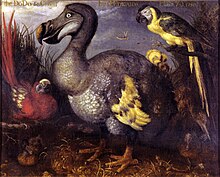Martinique macaw
Macaws were frequently transported between the Caribbean islands and the South American mainland in both prehistoric and historic times, so it is impossible to know whether contemporaneous reports refer to imported or native species.
The taxon was solely based on a 1630s account by the French priest Jacques Bouton [pt] of blue and orange-yellow macaws from the Lesser Antillean island of Martinique.
[4] The reassignment led to confusion as recently as 2001, when the American ornithologists Matthew Williams and David Steadman assumed the two names were meant to refer to separate birds.
[9] Another Savery painting from about the same time shows a similar blue and yellow macaw, as does a mid-1700s illustration by the English naturalist Eleazar Albin.
[10] In 1936, the Cuban scientist Mario Sánchez Roig claimed to have found a stuffed Martinique macaw specimen, which was supposed to have been collected in 1845.
After examination the same year, the American ornithologist John T. Zimmer showed it to be a hoax, combining a burrowing parakeet (Cyanoliseus patagonus byroni) with the tail of a dove.
He renamed it Ara erythrura, based on a 1658 description by the French pastor Charles de Rochefort [fr], and conceded that its provenance was unknown.
[6][11] Greenway suggested Rochefort's description was dubious, as he had never visited Jamaica, and appeared to have based his account on one by the French friar Jean-Baptiste Du Tertre.
Parrots were important in the culture of native Caribbeans, were traded between islands, and were among the gifts offered to Christopher Columbus when he reached the Bahamas in 1492.
[4]In spite of the fact that the tail of "Ara erythrura" was described as entirely red, the plate in Rothschild's Extinct Birds showed a blue tip, which the American ornithologist Charles Wallace Richmond complained about in his review of the book.



